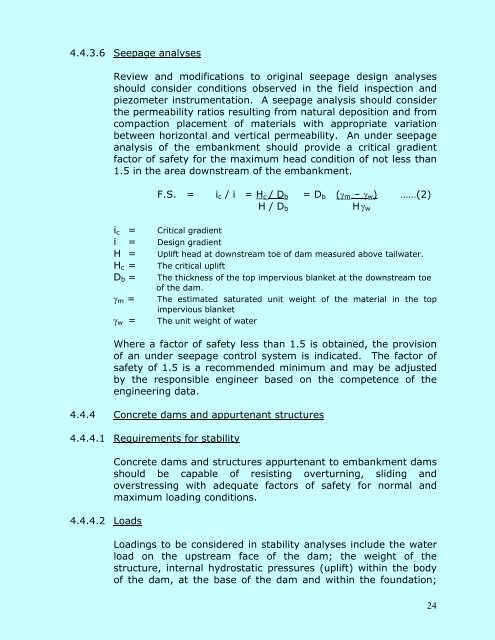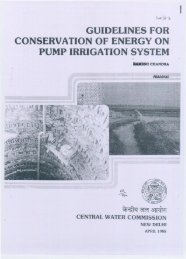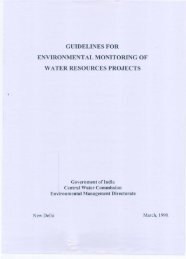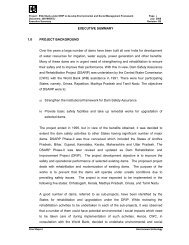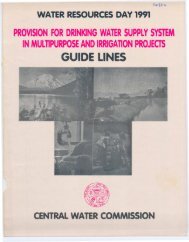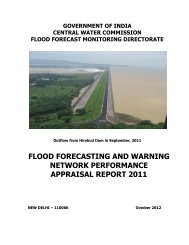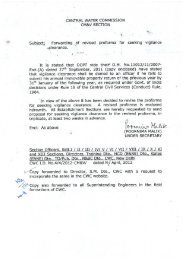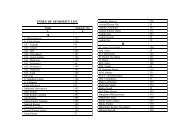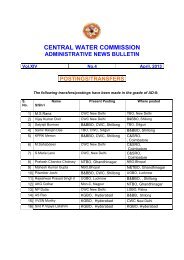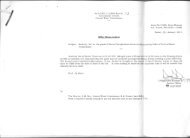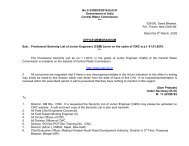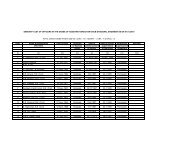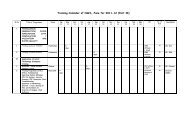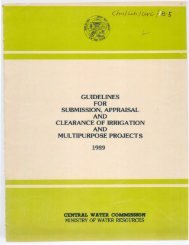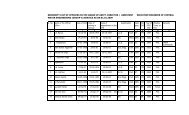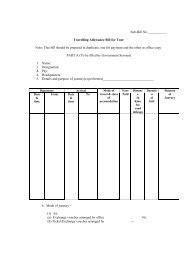Guidelines for Safety Inspection of Dams - Central Water Commission
Guidelines for Safety Inspection of Dams - Central Water Commission
Guidelines for Safety Inspection of Dams - Central Water Commission
Create successful ePaper yourself
Turn your PDF publications into a flip-book with our unique Google optimized e-Paper software.
4.4.3.6 Seepage analyses<br />
Review and modifications to original seepage design analyses<br />
should consider conditions observed in the field inspection and<br />
piezometer instrumentation. A seepage analysis should consider<br />
the permeability ratios resulting from natural deposition and from<br />
compaction placement <strong>of</strong> materials with appropriate variation<br />
between horizontal and vertical permeability. An under seepage<br />
analysis <strong>of</strong> the embankment should provide a critical gradient<br />
factor <strong>of</strong> safety <strong>for</strong> the maximum head condition <strong>of</strong> not less than<br />
1.5 in the area downstream <strong>of</strong> the embankment.<br />
F.S. = ic / i = Hc / Db = Db (γm – γw) ……(2)<br />
H / Db H γw<br />
ic = Critical gradient<br />
i = Design gradient<br />
H = Uplift head at downstream toe <strong>of</strong> dam measured above tailwater.<br />
Hc = The critical uplift<br />
Db = The thickness <strong>of</strong> the top impervious blanket at the downstream toe<br />
<strong>of</strong> the dam.<br />
γm = The estimated saturated unit weight <strong>of</strong> the material in the top<br />
impervious blanket<br />
γw = The unit weight <strong>of</strong> water<br />
Where a factor <strong>of</strong> safety less than 1.5 is obtained, the provision<br />
<strong>of</strong> an under seepage control system is indicated. The factor <strong>of</strong><br />
safety <strong>of</strong> 1.5 is a recommended minimum and may be adjusted<br />
by the responsible engineer based on the competence <strong>of</strong> the<br />
engineering data.<br />
4.4.4 Concrete dams and appurtenant structures<br />
4.4.4.1 Requirements <strong>for</strong> stability<br />
4.4.4.2 Loads<br />
Concrete dams and structures appurtenant to embankment dams<br />
should be capable <strong>of</strong> resisting overturning, sliding and<br />
overstressing with adequate factors <strong>of</strong> safety <strong>for</strong> normal and<br />
maximum loading conditions.<br />
Loadings to be considered in stability analyses include the water<br />
load on the upstream face <strong>of</strong> the dam; the weight <strong>of</strong> the<br />
structure, internal hydrostatic pressures (uplift) within the body<br />
<strong>of</strong> the dam, at the base <strong>of</strong> the dam and within the foundation;<br />
24


